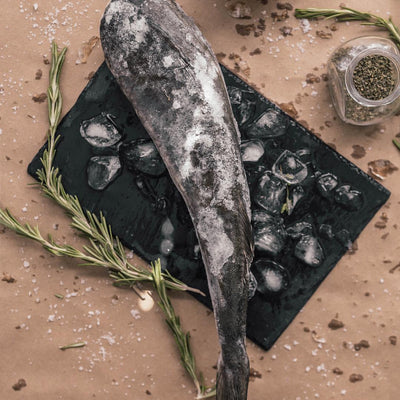Black Cod Health Benefits: Why Sablefish Is a Nutritional Powerhouse

Black Cod Health Benefits
Black cod, also known as sablefish, is a culinary gem from the cold waters of the Pacific. Known for its rich, buttery flavor and delicate texture, this fish is more than just delicious—it’s a nutritional powerhouse. Packed with omega-3 fatty acids, protein, and essential vitamins, black cod supports heart health, brain function, and overall well-being.
In this guide, we’ll dive deep into the health benefits of black cod, explore its nutritional profile, and share tips on incorporating this sustainable seafood into your diet.
What Is Black Cod (Sablefish)?
Black cod, commonly called sablefish, is a deep-water fish found in the North Pacific Ocean, particularly near Alaska. Its high fat content gives it a luxurious, melt-in-your-mouth texture that’s highly prized by chefs and seafood enthusiasts.
Why Is Black Cod So Nutritious?
Sablefish stands out for its rich concentration of healthy fats, particularly omega-3 fatty acids, which are essential for heart and brain health. Additionally, its high protein content and abundance of vitamins and minerals make it a nutrient-dense choice.
Explore premium sablefish options:
Nutritional Profile of Black Cod
Black cod is loaded with essential nutrients that contribute to overall health:
| Nutrient | Amount (Per 100g) | Health Benefits |
|---|---|---|
| Omega-3 Fatty Acids | 1.8g | Reduces inflammation, supports heart health |
| Protein | 20g | Builds and repairs muscles |
| Vitamin D | 15mcg | Strengthens bones, boosts immune function |
| Selenium | 36mcg | Acts as an antioxidant, supports thyroid health |
| Vitamin B12 | 2.5mcg | Aids in energy production and red blood cell formation |
Key Health Benefits of Black Cod
1. Supports Heart Health
The omega-3 fatty acids in black cod are known to reduce bad cholesterol levels, lower blood pressure, and improve overall cardiovascular health. According to the American Heart Association, consuming omega-3-rich fish like black cod twice a week can significantly lower the risk of heart disease.
2. Promotes Brain Function
Omega-3s are critical for brain health, improving cognitive function and reducing the risk of neurodegenerative diseases like Alzheimer’s. Black cod’s high omega-3 content makes it a smart choice for supporting memory and mental clarity.
3. Strengthens Bones and Teeth
Black cod is a rich source of vitamin D, which helps the body absorb calcium and maintain strong bones and teeth. It’s especially beneficial for individuals who get limited sun exposure.
4. Boosts Immune Health
The combination of selenium and vitamin D in sablefish supports a robust immune system, protecting the body from infections and illnesses.
5. Supports Muscle Growth and Recovery
Black cod’s high protein content makes it an excellent choice for athletes and active individuals, aiding in muscle repair and growth.
Why Black Cod Is a Sustainable Choice
Sablefish is not only healthy but also sustainably harvested. Fishing practices for black cod are regulated to ensure the species’ long-term viability, making it an eco-friendly seafood choice.
Explore sustainable black cod options:
How to Cook and Enjoy Black Cod
Black cod’s rich, buttery flavor makes it incredibly versatile in the kitchen. Here are some popular ways to prepare it:
1. Miso-Marinated Black Cod
- Marinate sablefish in a mixture of miso paste, sake, and mirin for 24 hours.
- Bake or broil until caramelized and flaky.
2. Grilled Black Cod
- Brush with olive oil, lemon juice, and fresh herbs.
- Grill over medium heat for 4–5 minutes per side.
3. Smoked Black Cod
- Perfect for charcuterie boards, salads, or as a savory breakfast topping.
Explore more options:
FAQs About Black Cod
1. Is black cod high in mercury?
No, black cod is considered low in mercury, making it a safe choice for regular consumption.
2. How often should I eat black cod?
The FDA recommends eating omega-3-rich fish like black cod 2–3 times per week.
3. What does black cod taste like?
Black cod has a rich, buttery flavor with a delicate texture that melts in your mouth.
4. Is black cod good for weight loss?
Yes, black cod is low in calories but high in protein and healthy fats, making it ideal for weight management.
5. Where can I buy high-quality black cod?
Shop premium black cod at Global Seafoods.
Get Inspired with Global Seafoods
Discover the finest black cod and other luxurious seafood options at Global Seafoods. Learn how to prepare gourmet dishes with step-by-step tutorials on the Global Seafoods YouTube Channel.
Conclusion
Black cod, or sablefish, is a nutritional powerhouse that combines indulgent flavor with significant health benefits. From supporting heart and brain health to boosting immunity and strengthening bones, black cod is a must-have for anyone seeking a delicious and nutritious seafood option.
Ready to enjoy the rich, buttery flavor of black cod? Shop premium sablefish at Global Seafoods and elevate your meals with this luxurious, sustainable seafood choice today!
Also in News

How to Make Sea Bream Sushi With Dry-Aged Tuna & Crab Roll — Step-by-Step With Chef Joshua
A complete guide to making Sea Bream sushi at home, including filleting, curing, slicing, and building a Dry-Aged Tuna & Crab sushi roll. Chef Joshua shares professional tips for restaurant-quality results.

Boiled Crab for Game Night: Everything You Need for a Perfect Seafood Party
Take your game night to the next level with a Boiled crab party. Learn the best recipes, cooking tips, and hosting hacks for a memorable seafood feast.

Boiled Crab for Date Night: A Romantic Guide to the Perfect Seafood Feast
Make your next date night unforgettable with a romantic Boiled crab experience. This guide covers everything you need to know, from ambiance to the best crab varieties.

